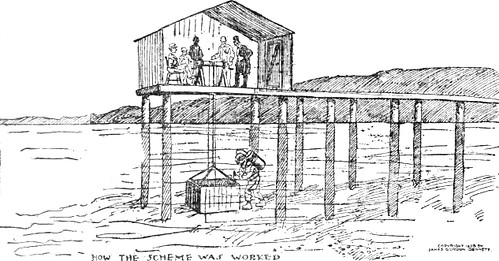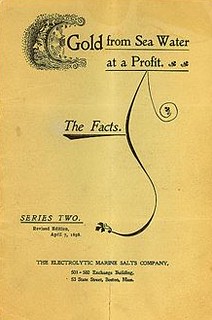
PREV ARTICLE
NEXT ARTICLE
FULL ISSUE
PREV FULL ISSUE
THE NEW ENGLAND GOLD HOAX OF 1898Gosh, why does getting gold out of the ocean have to be so darned hard? Why not just suck it up with a giant vacuum cleaner? Well, the laws of physics are stubborn things, but the
PROMISE of gold has always proved a handy means of sucking money from investors. Here's an interesting Atlas Obscura story of a 19th century scheme to extract gold from ocean water.
-Editor
According to the National Ocean Service, our oceans hold some 20 million pounds of gold, suspended in normal seawater. But this gold is spread throughout the normal mineral content of seawater to the tune of “parts per trillion.” As the NOAA puts it, “Each liter of seawater contains, on average, about 13 billionths of a gram of gold.” There are also gold deposits within the seafloor, but profitably mining them is far beyond our current abilities. Nonetheless, gold is gold, and it has a way of making people believe all sorts of speculative things. Ever since British chemist Edward Sonstadt discovered that there was gold in seawater in 1872, there have been those who have tried to capitalize on it, honestly or not. The earliest, and largest, attempt to mine the oceans for gold took place in the 1890s. And it was all a hoax. The scam began when New England pastor Prescott Ford Jernegan claimed to have invented a “Gold Accumulator” that could suck gold from seawater via a process involving specially treated mercury and electricity. Claiming that the inspiration for the contraption had come to him in a heaven-sent fever dream, Jernegan, along with childhood friend Charles Fisher, started the Electrolytic Marine Salts Company. Jernegan performed a seemingly successful demonstration of the accumulator to some potential investors, and they were off and running. An attractive prospectus was drawn up that claimed there was “enough gold in the waters of Long Island Sound to pay off the National Debt and leave a larger gold reserve in the Treasury than the Government has yet possessed.” According to the New England Historical Society, by 1898, Electrolytic Marine Salts had garnered around $1 million in investor cash. The company opened a gold-extraction plant in remote Lubec, Maine, where their operations would be less likely to be inspected. The operation was to use 1,000 of the accumulators to drag the waters for gold. Excitement about the operation became such that work on a second, larger plant began, with the hopes that Lubec might be turned into a gold-rush boom town. However, in July of 1898, things fell apart. As the shareholders began wanting a closer look at their investment, both Jernegan and Fisher disappeared. According to The New York Times, Jernegen had recently taken out $80,000 in government bonds. It would come out that during the initial demonstration, Fisher had swum down to the accumulator and replaced the pure mercury with his own gold-laced mixture. The accumulators turned out to be little more than trumped-up soup kettles. When the hoax was exposed, hundreds who had come to Lubec for work were instantly unemployed, the plant was shut down, and the investors were out of their money. Jernegan fled to Europe with his family, and managed to weasel his way out of jail time, while Fisher was simply never heard from again. To read the complete article, see:
Here's more from the New England Historical Society. -Editor
 With offices opening quickly in New York, London and Boston, the Electrolytic Marine Salts Company announced its plans to the world. The papers were quick to spread the news that the company was accepting investors and that it would soon harvest tons of gold from the sea.
The money poured in, mostly from Massachusetts, Connecticut and New York. The company now had to set up shop and start operations. Looking for a place that would avoid prying eyes, they settled on Lubec, Maine. Its extremely high tides and strong currents, they explained, made it the perfect location. There, they leased a grist mill, constructed a series of underwater “accumulators” to harvest the gold, and employed more than 100 men. In Lubec, Fisher simply repeated his act, slipping under the water and salting the accumulators with gold to be brought to the surface, analyzed and shipped to the company’s offices in Boston. As the gold continued to come in to Boston, the word spread and more investors were induced to buy shares. New England Gold Hoax of 1898: Greed Meets Moxie . (www.newenglandhistoricalsociety.com/new-england-gold-hoax-1898/) THE BOOK BAZARREWayne Homren, Editor The Numismatic Bibliomania Society is a non-profit organization promoting numismatic literature. See our web site at coinbooks.org. To submit items for publication in The E-Sylum, write to the Editor at this address: whomren@gmail.com To subscribe go to: https://my.binhost.com/lists/listinfo/esylum All Rights Reserved. NBS Home Page Contact the NBS webmaster 
|
